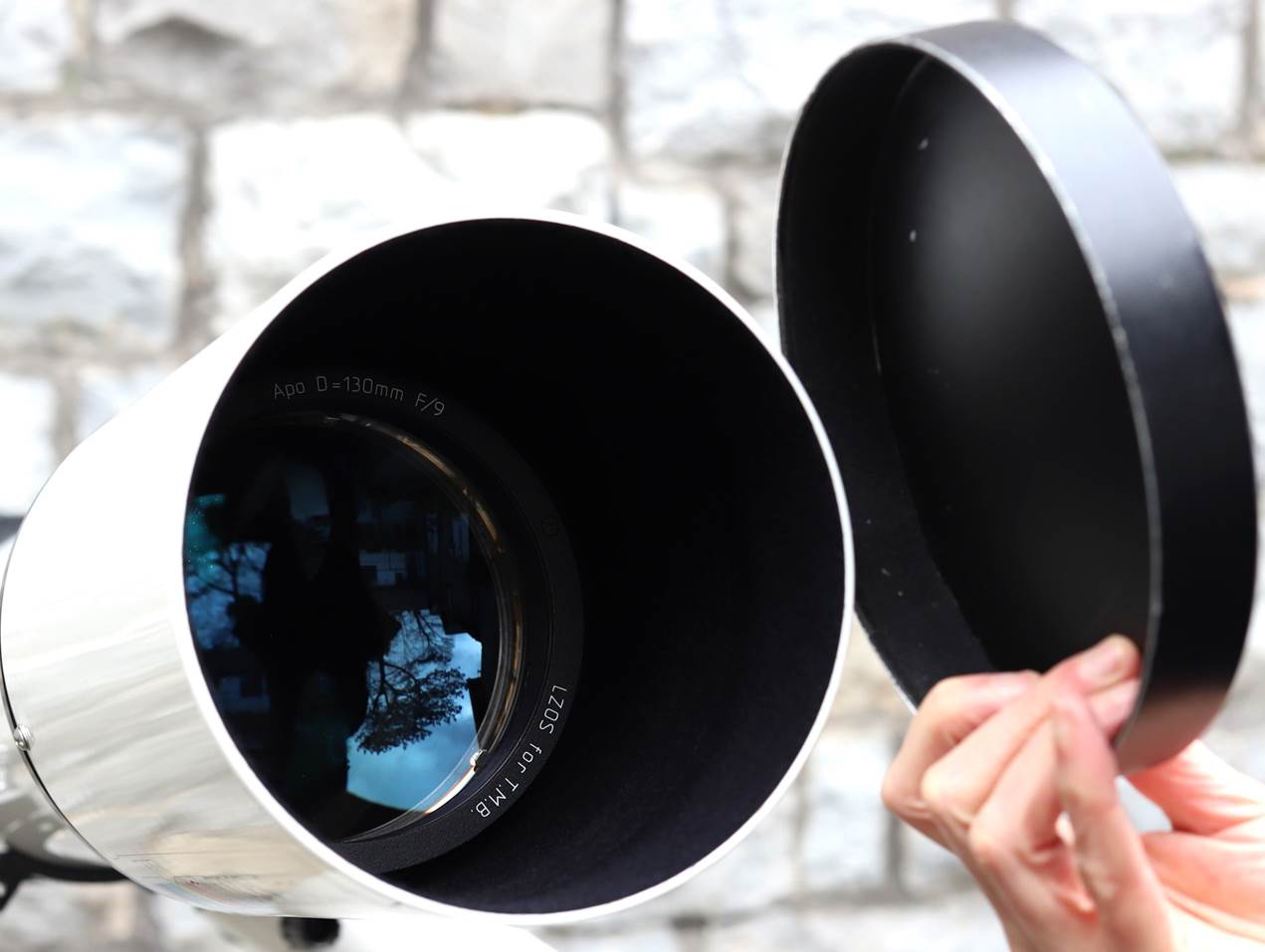LZOS
(APM/TMB) 130/1200 Review

Most folks want to image these day
– fair enough. But what if you’re a throwback who wants to see the
solar system with your own eyes? If you live high-up in Arizona, a big SCT or
Dob’ will serve you well; if you live somewhere with a maritime climate
and frequent poor seeing, not so much.
To
explore fine lunar and planetary detail under temperate skies, apochromats in
the 5” class are a sweet-spot for performance and usability. Easy to
handle alone and mountable on a medium equatorial, a 5” apochromat will
cool within an hour or so and resolve as much detail as the seeing allows
(~1”) most nights.
Undoubtedly
the best-corrected 130mm APO (perhaps even the best corrected refractor period)
is Takahashi’s TOA-130. However, it uses two ED elements and a large
air-gap to do it. This means it’s expensive, heavy and slow cooling.
Excluding the TOA, a strong candidate for the “best ever” 130mm
planetary refractor is reputedly the rare LZOS (TMB) 130mm F9. But given that
LZOS’s standard F6 130mm is already well corrected, could an F9 version
really be much different? Let’s see …
At A Glance
|
Telescope |
LZOS
(TMB/APM) 130/1200 |
|
Aperture |
130mm |
|
Focal Length |
1200mm |
|
Focal Ratio |
F9.23 |
|
Length |
128.5cm
dewshield and drawtube extended, 102 cm retracted. |
|
Weight |
2761 cell
+ 4125 tube = 6900g w/o rings |
Data from me.

Design and Build
The 130/1200 is an ED triplet objective
made by LZOS (more below). Early examples were designed by TMB, but something
very similar is still available with just LZOS/APM branding.
Most LZOS lenses are found in tubes
like this one, assembled by APM Telescopes in Germany. I’ve owned and/or
reviewed a number of other LZOS objectives in APM tubes, including the 100/800,
115/805 and 175/1400.
This is quite an old OTA, but the same
lightweight APM tube is still available with a variety of objectives. All
feature well-constructed and baffled tubes that are conventional until the
focuser end, where there’s a 3.5” drawtube. This make for a much more compact and
portable telescope. In this version, the focuser is a premium Starlight
Instruments Feather Touch, but more recent tubes can be found with other
focuser options.
The Competition
Takahashi’s
desirable-but-costly TOA-130 manages similar (probably marginally better)
correction at a significantly faster F7. But the large air-gap it employs to
improve correction makes such objectives sensitive to de-centring. It also
makes for a very heavy cell, so
the TOA needs a tube counterweight and ends up too heavy for a medium mount
like my SX2.
Astro
Physics’ Starfire 130 F8 is very similar to the 130/1200 in size and
weight, but it’s an old design now and correction isn’t quite as
good. More recent APs, like the 130 GTX, are F6 and aimed at imagers. They do
perform very well for visual use too, but again correction is likely not quite
up to the 130/1200. Overall performance of LZOS’ own 130 F6 is very
similar, but it’s often encountered in a heavy imaging-centric OTA
that’s overkill for visual use.
Takahashi’s
old FS-128 fluorite doublet is an all-time favourite. It cools faster than the
130/1200, but is just as heavy and even larger. Again, it doesn’t have
quite the perfect correction of the 130/1200, but the important red-end that
gets neglected in many scopes is well-corrected for Mars fans.
Older
William Optics 130s can be (very) dodgy optically and aren’t easily fixed
as the elements are cemented. More modern Chinese objectives are reputedly much
better, but I haven’t tried one.
LZOS
Transliterated from Cyrillic, the
acronym LZOS stands for “Lytkarino Zavod Optychisovo Sticklo”,
which translates to Lytkarino Optical Glass Works. LZOS are neither a
backstreet optical shop, nor a producer of consumer optics. Rather, LZOS are an
enormous manufacturing plant specialising in optics for the military and
research: astro’ objectives like this are a sideline. As I’ve noted
before, any western supplier of mil-spec optics could doubtless fabricate
something similar … at ten times the price.
One big LZOS advantage is that
they make the whole thing, from melting the glass to machining the cell. This
means that they can tailor crowns and flints to implement a specific design
very precisely – they are not dependent on existing glasses from the
likes of Schott and Ohara, though they do have a catalogue of standard glass
types. This also means they can make bigger objectives - up to 12” and
more. LZOS objectives are
consistently among the finest I encounter. Their only disadvantage is that
their cells are heavy.
LZOS lenses are most frequently
encountered in APM telescopes, but they have cropped up in other brands too,
including Stellarvue and William Optics.
Note: In early 2025, you
might still feel troubled about supporting a Russian military supplier.
Fortunately, this particular objective was made long ago, so no issues for me
around owning or reviewing it. Would I buy a new one? Probably! After all, how
many things do I own made by companies owned by the PRC, for example?
Optics
At an
aperture of four inches, a regular ~F8 ED triplet can deliver near perfect
correction for chromatic aberrations. Examples include the TMB 100/8 and
Takahashi TSA-102. However, at 130mm a slightly slower design is required to
achieve similar perfection, hence this 130/1200 (actually F9.2).
A slower
focal ratio can have benefits beyond correction. Thinner elements reduce weight
and can speed up cool-down. More importantly, a shallower light cone can make
finding perfect focus easier and improve image stability in poor seeing.
This
objective appears to be typical LZOS – a conventional triplet with a high-fluoride ED centre element flanked by two crowns and separated with small (foil
spaced) air gaps. LZOS don’t publish glass details, but I compared the
laser scatter with my LZOS 115/805 and the centre crown glass and the inner
flint are NOT the same (see below)! Despite just two f-numbers slower, the
elements in the 130/1200 are much thinner too.
The glass for
the 130/1200 is housed in a heavy cell with a temperature-compensating ring
that’s machined and blacked to resist stray light. The whole has an
artisanal feel, down to the hand-writing on the lens tapes. The cell is more sophisticated than the
115/805 and has a rear retaining ring with shims against the glass like the
larger 175/1400. Like other LZOS objectives, the cell
threads onto the lens ring; there is no way to adjustment collimation. The
thinner elements result in a cell weighing the same as the 123/738 (~2.75 Kg in
both cases).
Despite
being an older
lens, the coatings look excellent (LZOS likely do their own) and better than my
115/805, perhaps because this objective is later or possibly because it’s
effectively a premium model.

Two LZOS objectives from the same era: TMB 115/805
and TMB 130/1200. Cell design and coatings are different.

Laser shows glass types are different too (outer
crown on left in both). Note the thicker elements in the F7 TMB 115 (same laser
angle of incidence).
Tube
The
lightweight APM tube is made from Krupax, a phenolic resin impregnated
composite, not aluminium. It’s finished in a gloss white paint
that’s smart, but not as durable as powder coat. The drawtube, holder and
sliding dewshield ring are machined and black-anodised aluminium. Lightweight
APM tubes feature a sliding drawtube, with a travel of about 3.5”, to
reduce packed length and weight. In this case, retracting the drawtube and
dew-shield reduces the length from 128.5cm to just over a metre.
These
lightweight Krupax OTAs are the ‘budget’ line from APM and unlike
the heavier APM tubes without the drawtube, the sliding dewshield and back are
secured with screws, not threads. Another difference is the baffles. Here, the
baffles are simply glued in and the tube interior is painted flat black. The
high-end APM tubes have a baffle assembly inserted on rods and are fully
flocked to further eliminate stray light.
The pay-off
for this type of tube is much lighter weight: not much more than the 115/805
despite being so much longer and one of the lightest 5” APOs at ~7Kg for
the bare OTA. The premium OTA would be ~3Kg heavier. Another advantage of the
drawtube OTA is ease of use with a binoviewer.

TMB 130/1200
and 115/805, both in lightweight APM tubes.

APM’s
lightweight tubes feature a drawtube for coarse focusing that reduces the OTA
length when retracted.
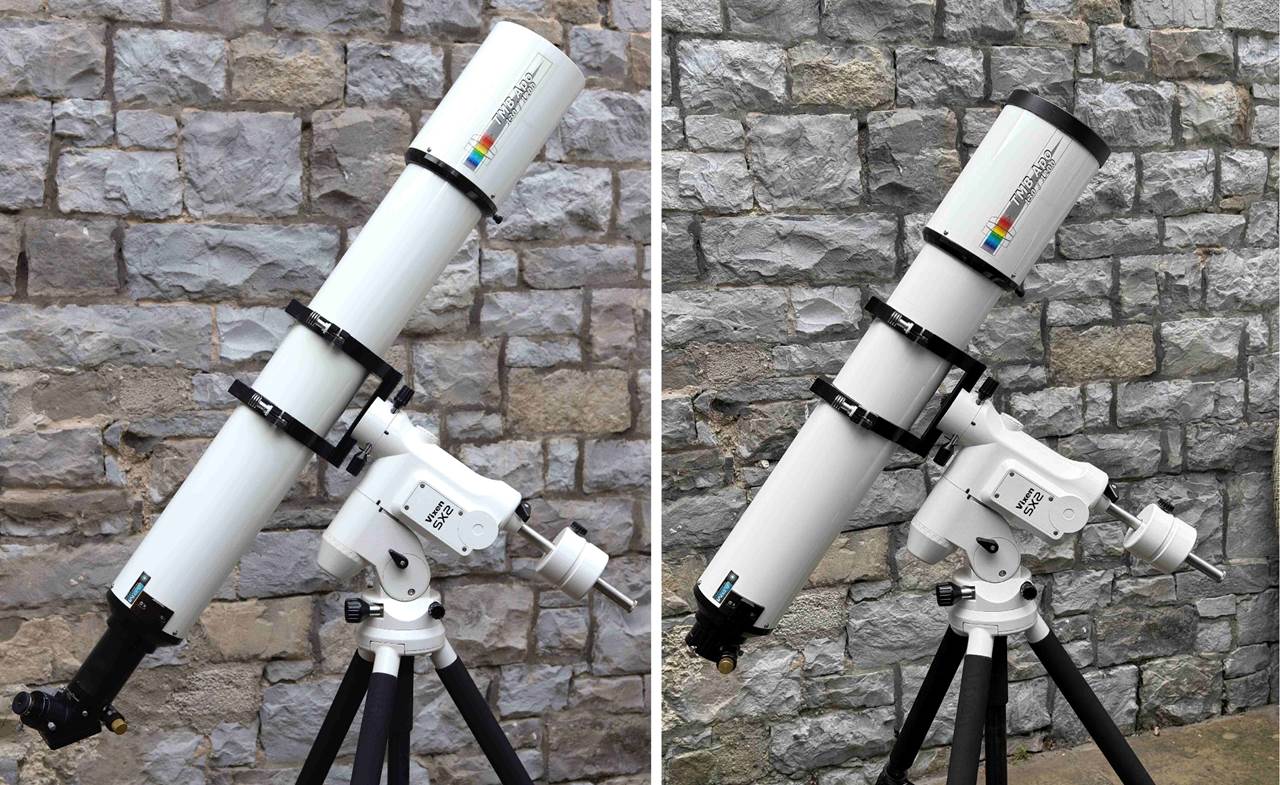
Drawtube and
Dewshield fully extended and fully retracted.
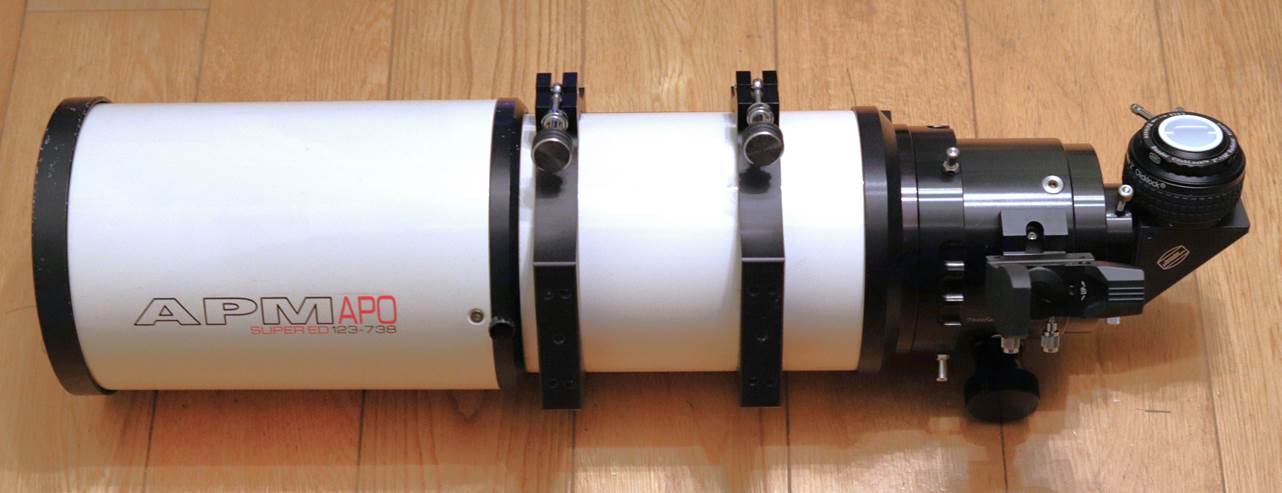
Example of a
premium APM/LZOS OTA with 3.5” rack-and-pinion Feather Touch focuser.
Focuser
These early
TMB-badged lightweight (draw-tube) OTAs feature a small Starlight Instruments
Feather Touch Crayford focuser. Later versions may feature other focusers,
including an APM-badged Chinese rack-and-pinion that’s very decent but
not as good as the FT. The premium OTA typically employs a big 3.5”
rack-and-pinion Feather Touch (above).
Would you be
better off with the same objective in a premium OTA with the big focuser then?
In this case, I don’t think so. The 3.5” FT is great for serious
imagers with cooled cameras and filter wheels. But this is a high-mag’
visual specialist and the small focuser is sufficient. The Crayford also has an
edge in absolute smoothness and precision.
This Feather
Touch has a body just 1.5” long and a 2.5” diameter drawtube with a
shortish 2.5” travel. As usual with an FT, the dual-speed pinion has a
gold fine focus knob and a locking thumbscrew underneath. All the parts are
milled from hard stainless. It’s a beautifully fabricated, if expensive,
device.
The drawtubes
in some early tubes had dodgy fit, with slop between the drawtube and bushing,
but (like my 115/805) this one works perfectly. It does shorten the tube
significantly, but is more hassle in use because the short travel of the FT
means you have to adjust coarse focus with the drawtube.
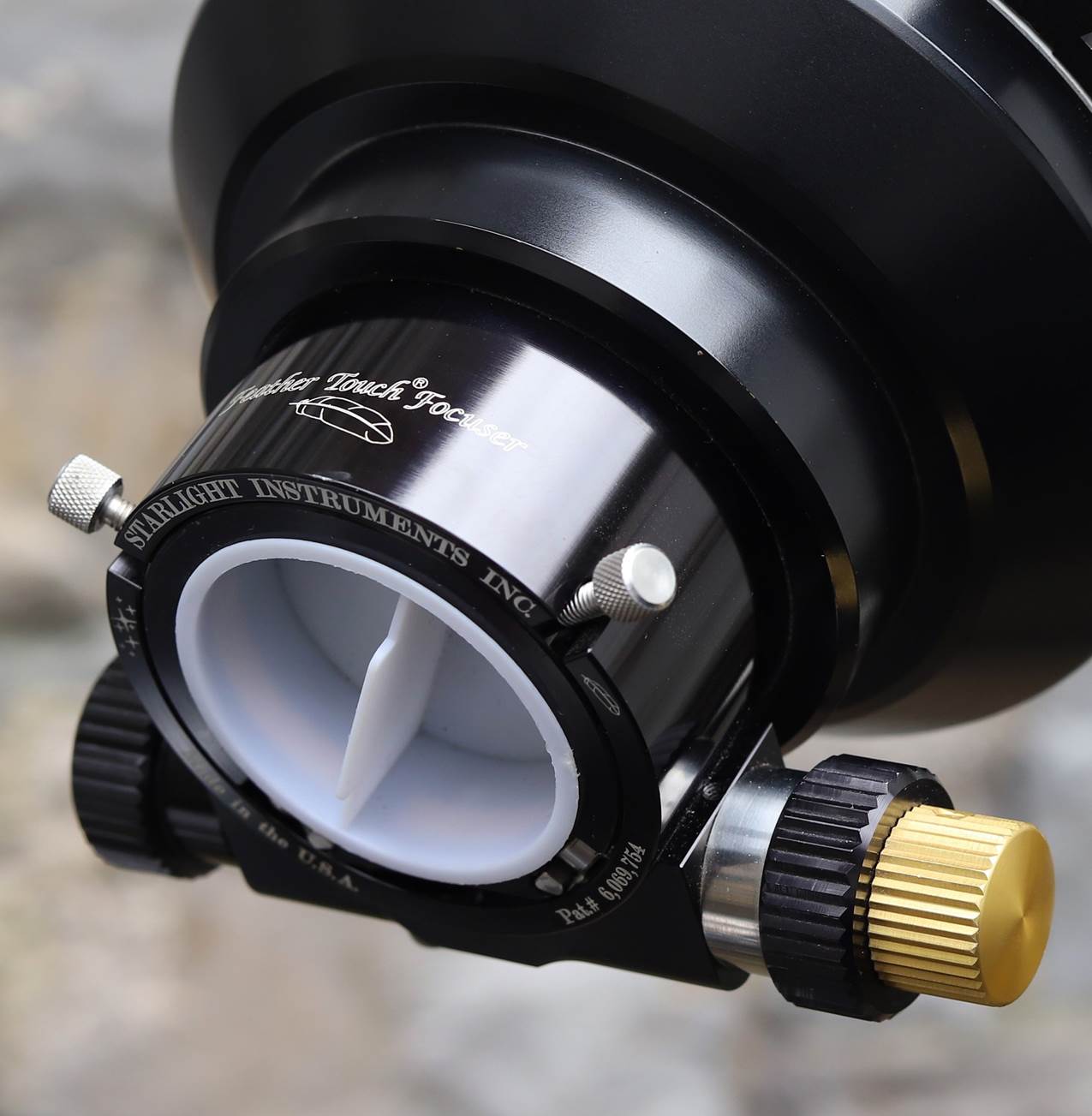
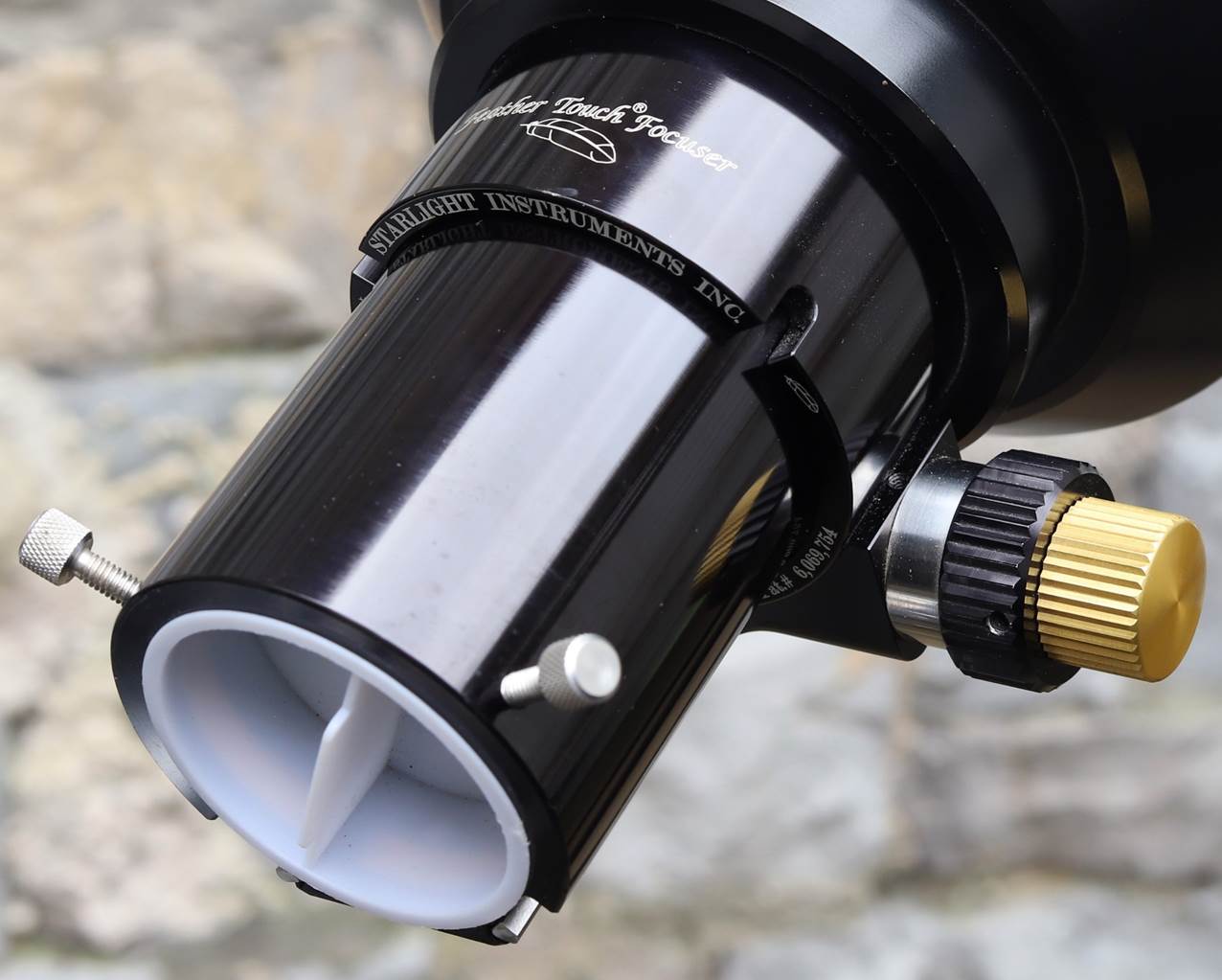
Mounting
The
shortened Krupax tube, small focuser and thin lens elements thanks to the long
focal length make this a very light 5” refractor. I was surprised to find
it well supported by my Vixen SX2 mount, with only modest vibes and perfectly
usable at high power. Any medium equatorial or larger alt-az (Rowan etc) should
cope fine. Unlike larger LZOS scopes (and indeed Tak’s TOA-130), this one
balances fairly centrally and needs no tube counterweight, again thanks to the
light (for an LZOS) cell.
The rings
have the APM-usual mix of ¼-20 centre threads for most Vixen plates
combined with AP-pattern for larger D-series plates.
Accessories
You will obviously need a quality 2” diagonal and some decent eyepieces. This optic is so good there is some small advantage in using specialist planetary eyepieces: as usual, I got my best views with a TMB Monocentric.
In Use – Daytime
My usual
prime focus snap of branches against a bright cloudy sky, over exposed by one
f-stop, is very revealing of false colour fringing and light bleed. The
130/1200 is perhaps the best I’ve seen in this test. ‘Nuff said.

Over-exposed branches with 100% crop inset: almost
no fringing.
In Use – Astrophotography
The
130/1200 is photographically pretty slow at F9.2 and was obviously designed for
visual use, but I did my usual test snap of the Pleiades for interest (taken in
some moonlight, unfortunately). For one thing, control of violet bloat on hot
stars is exceptionally good – noticeably better than another very well
corrected planetary APO, Takahashi’s FC-100DZ. The field is also
surprisingly flat, even at full-frame. On APSC chips, you might well get away
without a flattener. In all cases, you need the drawtube at full extension and
a further extension tube to get focus.
As usual
with larger LZOS lenses, the 130/1200 takes exceptional one-shot snaps of the
Moon, no stitching or stacking required.

Alcyone and Merope, 30s ISO 3200 with Canon EOS 6D
MkII: Takahashi FC-100DZ left, TMB 130/1200 (some Moonlight) right.
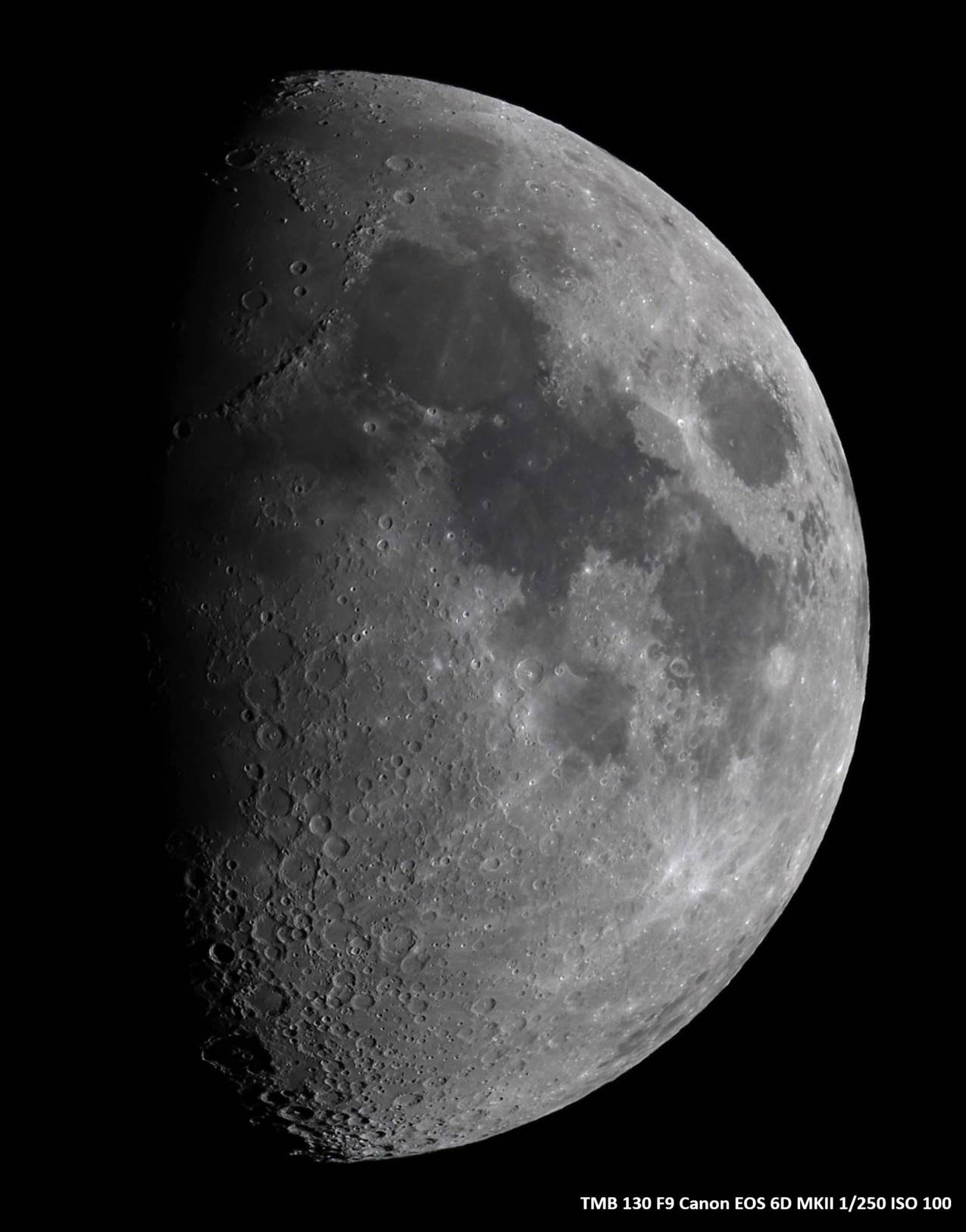
In Use – Observing the Night Sky
General Observing Notes
The
130/1200’s shallow light cone gives a long sweet-spot and makes it very
easy to get perfect focus. The Crayford FT works superbly as usual, with no
slop or image shift and very precise micro-focus, effective lock. Despite its
small body, the FT copes perfectly with a heavy eyepiece or DSLR, but imagers
using heavy cooled cameras and filter wheels would be better off with one of
the larger focusers fitted to the high-end OTAs.
The TMB
130mm F9 is a planetary specialist, so I’ll look at its planetary and
lunar performance in detail.
Cool Down
Cool-down
wasn’t terrible for a 5” triplet: usable after about ~40 minutes,
it needs over an hour from a warm house for tube currents to settle and give
its best.
Star Test
A perfect star test
with identical rings either side, evenly illuminated and spaced.
The Moon
Even in
very average seeing, the TMB gave one of the best views of 9 day Moon I can
recall, with extraordinary fine detail on view – rilles, craterlets, and
dome fields. Highlights were many
and I just wanted to view, but included the Hadley Rille and nearby Fresnel and
Bradley rilles; the rille system and craterlets, dark patches in Alphonsus; the
Apennine palisade catching the dawn.
At 167x
with a 7mm T6 Nagler, there was no false colour, even focusing through limb.
Light bleed can spoil the view of limb features in lesser scopes, but not here.
Now I realise most apochromats create some false colour in the black terminator
shadows and bright highlights, but again not here – just pure whites and
blacks.
Venus
At 130x with a 9mm
T6 Nagler, Venus was perfectly sharp, dazzling crescent with no false colour in
focus. Even the out-of-focus gold blur you get with most triplets was
completely absent. I noted a hint of ashen light and definite indentations on
terminator. This was possibly my best view ever of Venus in a refractor larger
than 100mm.
Mars
I viewed
Mars at 13.2” across, a few weeks after the 2025 opposition. I tried a
variety of eyepieces and magnifications, but a 5mm TMB Mono gave the best
view at 234x. And what a view! One of the sharpest and highest contrast ever
with a small scope – bright north cap, Mare Acidalium, the dark stripe in
the south with fingers reaching up towards the equator – Sabeas,
Meridiani, Margaritifer Sinuses.
Again,
there was no false colour or stray light in or out of focus, not even the hint
of red blur out of focus that almost all “apochromats” produce,
many triplets included. Here the orange disk was perfectly sharp and true
colour. Wonderful.
Jupiter
I struggled to get
a good view of Jupiter due to its position at the time – above roofs and
chimneys sloughing shimmering air. But I noted all the usual features,
nonetheless – colour and density variations in the NEB and SEB, polar
hoods, equatorial dark band.
Deep Sky
This is a
specialist planetary scope, but unlike say a big Maksutov, it gives wonderful
deep sky views too. The whole Pleiades easily fit in the frame of a low-power
eyepiece and the field is natively well-corrected to the edge. Star images are
very small and intense and free from any false colour at all that I could find.
Even O-A stars at high power are perfectly, dazzlingly bluish white in or out
of focus.
As you
might expect, the very tight PSF makes this a stunning double-star splitter. My
usual doubles were too easy, so I went hunting for more challenging examples.
The best I could find – Eta-Orionis at 1.7” – still
didn’t tax the 130/1200.
Summary
The
130/1200 really surprised me, something I always enjoy. I expected a small
incremental benefit over a faster LZOS triplet, but it didn’t feel like
that. In ordinary seeing, the 130/1200 simply gave the best planetary views
I’ve ever had at this aperture: absolute clarity and sharpness, no false
colour at all, maximum contrast.
But why
though? Perfect correction for spherochromatism and false colour are part of it
– no red blur on Mars or gold on Venus, no flare of unfocussed light, no
colours bleeding into lunar shadows. But that slow focal ratio indeed seemed to
make finding and holding focus easier too. Or perhaps LZOS injected some magic
into the design itself.
Whatever
the reason, the 130/1200 might just be my favourite ever specialist planetary
scope - the very best, if like me you live somewhere where the seeing is often
mediocre and you need to take advantage of brief viewing opportunities. If you
don’t plan to mount it in an observatory, this lightweight version is the
one to go for too.
If solar system viewing under murky
northern skies is your thing, the LZOS 130/1200 is the pinnacle. Highly
recommended if you can track one down.
